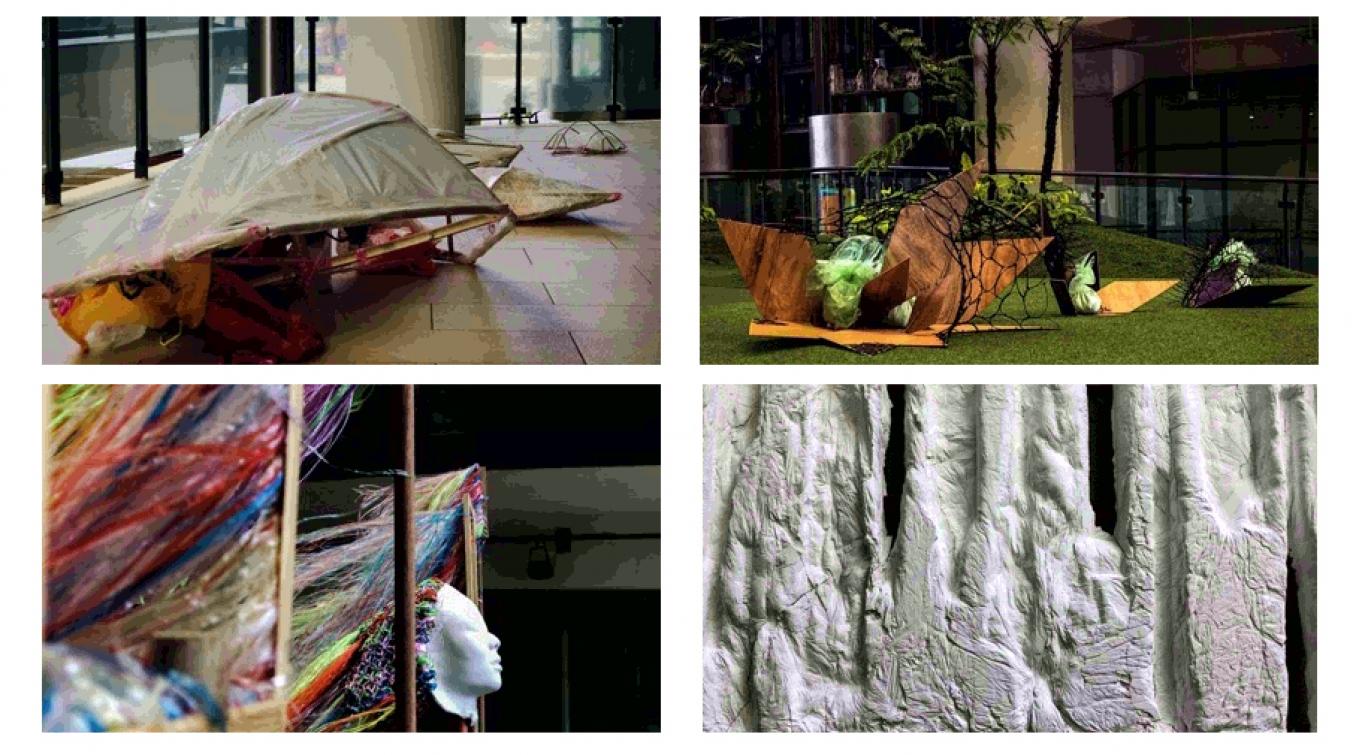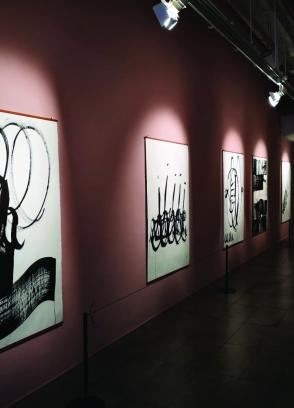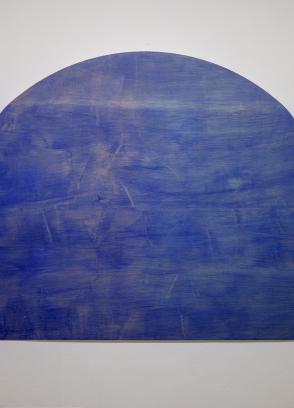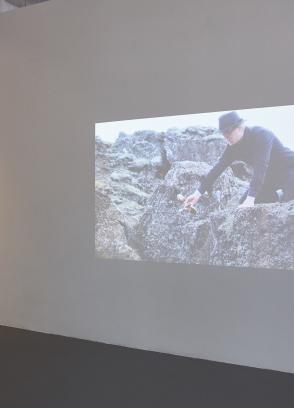by Rozells Stacey Gabrielle and Muhammad Rusydan Bin Md Norr, Diploma in Fine Arts Level 2 (2019)
“It is estimated that 1.15 to 2.41 million tonnes of plastic are entering the ocean each year from rivers. More than half of this plastic is less dense than water, meaning that it will not sink once it encounters the sea.”
Floating Island is a reference to what is known as the Great Pacific garbage patch—gigantic floating islands of waste in the Pacific oceans. Participating students were given this as a contextual departure point for them to expand on and examine current similar issues in Singapore, and the surrounding region.
Over the course of less than a week of intensive workshops, students were mentored by James L. Hayes and LASALLE alumna Kathryn Kng, who worked extensively with James in his iron casting project known as Iron Project.
This Sculpture Week brought students from Diploma Level 3, BA and MA Fine Arts, working collectively, in pairs or individually, to develop a series of sculptural works, drawing from an array of found, gathered and manufactured materials.
Preliminary ideas that were proposed prior to the workshops, evolved and culminated in different outcomes for the exhibition that opened on 8 March 2019. Nonetheless, the four days was productive and students involved learned an invaluable skill in casting and sculpting. The few who were not from a sculpture discipline during their specialism year, learnt to work with tools and materials that they would not have otherwise. The road beyond has been laid with more possibilities for them, as young artists and students to explore the potential of their respective interests in materials for sculpting.
At the end of Sculpture Week, we asked the participating students to contribute a succinct statement of their works, how they explored the materials and what are the thought processes behind them. What follows here are documentation of their works and the artists’ responses:
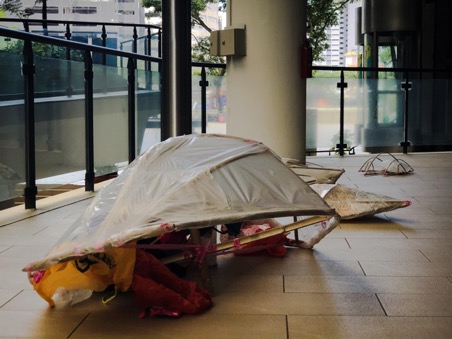 Shane Ng Bing Ming, Shall We Change? Mixed media. Dimensions variable.
Shane Ng Bing Ming, Shall We Change? Mixed media. Dimensions variable.
Shane Ng Bing Ming, MA Fine Arts
My work uses the shape of the sea turtle shell as a visual representation of the marine life that was affected by the trash human produced. I used mainly bamboos for the structure and also the trash I collected during the project. The concept behind the material for the husk suggests the light weighted shell that would no longer grow.
The title, Shall We Change? presses the viewer to question if it was perhaps time to change, or to act while we can.
Nur Liyana Binte Ali, MA Fine Arts
Of Stratification and Heedlessness was inspired by the layers of the earth, namely land, sea and sky which I find akin to the layers of trash in the sea and the sense of suffocation between buildings that are within close proximity.
As time passes, we demolish and reconstruct so as to modernise our landscapes, but what happens to the rubble and debris?
The plaster piece in this work is the ‘white elephant’ that represents the amount of rubbish that we do not see. We are delusional to think that the amount of waste we produce does not have an impact on the environment or ourselves; it gets overlooked as many of us take the environment for granted thereby causing it to accumulate.
Of Stratification and Heedlessness is a commentary on the mould and cast, in this case, that it belies the questions, which came first? or where it does it come from? in relation to the theme of floating islands.
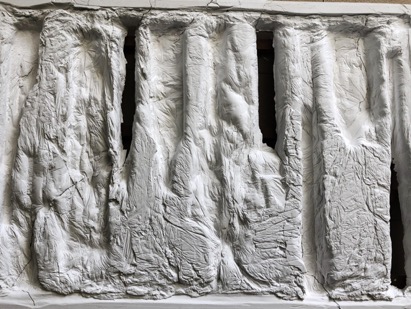 Nur Liyana Bte Ali, Of Stratification and Heedlessness. Mixed media. Dimensions variable
Nur Liyana Bte Ali, Of Stratification and Heedlessness. Mixed media. Dimensions variable
Lewis Choo Li Wei, BA(Hons) Fine Arts
Home, the connection between humans comes with different stories. Home is not only place of comfort but within there are rules and orders. My father’s teaching plays a big part in my practice.
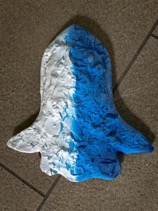 Lewis Choo Li Wei, Melancholy Blues. Plaster cast. Dimensions variable
Lewis Choo Li Wei, Melancholy Blues. Plaster cast. Dimensions variable
My work is an examination of different Chinese/Japanese folktales and cultures, and the thinking behind those tales. People might lost the sense of tradition but we can manipulate it into the topic of modernity by altering them in a way of questioning the norms which have formed the environment and our behaviour.
Andrea Tan Shi Qi, Diploma in Fine Arts
Untitled is a two-piece sculptural installation comprised of steel frames, collected plastic bottles and found objects. Our group wanted to focus on the idea of marine debris and movement of plastics through the ecosystem, and we came up with this wave- and appendage-like form. We wanted to keep the work abstract and up to individualistic interpretations, but for us, we felt that the forms represented the ocean, the textures of the plastics from the hanging piece represents all the different organisms affected by marine pollution, while the suspended objects in the standing piece represented human interference within the marine ecosystem.
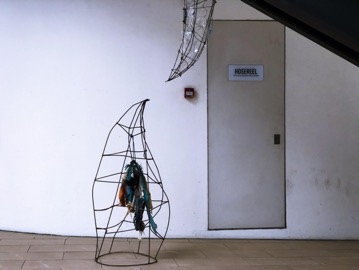
Azirah Jamal, Diploma in Fine Arts
Industrial Reproduction was a portrayal of a mutated animal from the ocean due to contamination. All sewage, harmful synthetic concoctions from ventures, atomic waste, thermal pollution, plastics, corrosive downpour, and oil spillage have driven a wide variety of marine creatures to suffer malignancy, failure in the reproductive system, behavioural changes, and mainly death. As years pass, researchers found that the poisons and radiation cause transformations on the cellular level which is extremely detrimental to the natural world.
The three sculptures were a portrayal of a mother with her two kids. Cable ties were attached on each individual sculpture to represent their being ambushed and trapped. Melted black glue seen on arbitrary pieces of its body imitates as tar and toxic.
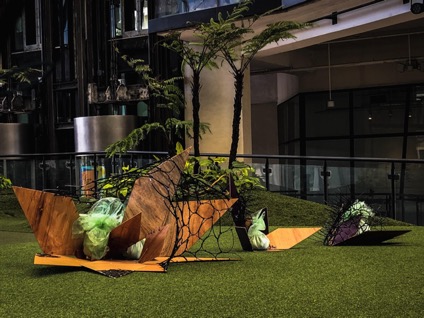 Azirah Jamal, Industrial Reproduction. Plywood, Cable ties, Black glue. Dimensions Variable.
Azirah Jamal, Industrial Reproduction. Plywood, Cable ties, Black glue. Dimensions Variable.
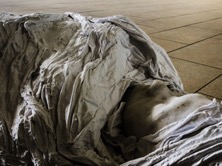
Benedict Yeo Jun Sin,
Diploma in Fine Arts
I have actually been doing casting for quite a while, however, Floating Body was the first time I got to use alja-safe and execute a full body cast. The work is about how when we dispose of rubbish and it gets into the sea, the rubbish as microplastic returns to us through the seafood we consume, slowly poisoning and killing us.
Muhammad Rusydan,
Diploma in Fine Arts Partially overlapping what I was doing before for my practice, which was repurposing plastic straws and water babies as a sculptural material, here, I incorporated the sound of myself sipping out of a straw, among other actions, that was played during the opening. The initial idea was to have water itself in the installation, but due to safety reasons, I was discouraged from doing so. So, the alternative idea was to have water sounds instead. At the same time, it got me to start to thinking about, consumerism or more specifically, our insatiable thirst, how we constantly depend on these materials that we know to have had irreversible damage on marine life. Hence the title, Beyond Our Thirst.
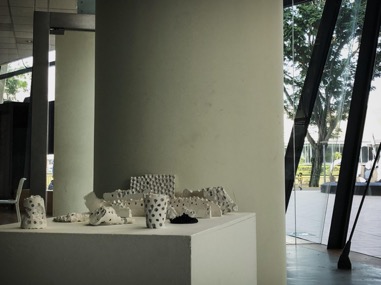 Muhammad Rusydan, Beyond Our Thirst, Plaster, Crystal Soil, Recycled straws, audio. Dimensions variable.
Muhammad Rusydan, Beyond Our Thirst, Plaster, Crystal Soil, Recycled straws, audio. Dimensions variable.
Sarah Lin, Diploma in Fine Arts
One thing that I enjoy immensely is nature, especially sitting under a shady tree during a hot and humid afternoon and listening to the leaves whispering with a breeze. I noticed that the crash of an ocean wave is similar to the sound trees produce when a strong wind hits them, and thus wanted to bring this sound into the school for Sculpture Week. Traditionally a 2D visual person, sculpture is something new in my arena, and I have been lately obsessed with the household item of brightly coloured plastic raffia strings. As the natural element of the wind activates the artwork, onlookers are treated to the ‘shaah shaah’ of the shredded raffia string dancing with the wind.
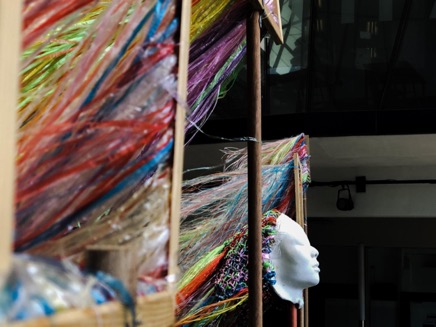 Sarah Lin, Siren’s Song. Raffia Strings, Canvas frame, Wood, Bamboo, Plaster Cast. Dimensions variable.
Sarah Lin, Siren’s Song. Raffia Strings, Canvas frame, Wood, Bamboo, Plaster Cast. Dimensions variable.

